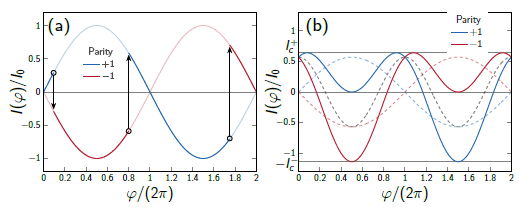Parity protected superconducting diode effect in topological Josephson junctions
Henry F. Legg1, Katharina Laubscher1,2, Daniel Loss1, and Jelena Klinovaja1
1 Department of Physics, University of Basel, Klingelbergstrasse 82, CH-4056 Basel, Switzerland
2 Condensed Matter Theory Center and Joint Quantum Institute, Department of Physics, University of Maryland, College Park, Maryland 20742, USA
In bulk superconductors or Josephson junctions formed in materials with spin-orbit interaction, the critical current can depend on the direction of current flow or of applied magnetic field, an effect known as the superconducting (SC) diode effect. Here, we consider the SC diode effect in Josephson junctions in nanowire devices. We find that the 4π-periodic contribution of Majorana bound states (MBSs) to the current phase relation (CPR) of individual junctions results in a significant enhancement of the SC diode effect when the device enters the topological phase. Crucially, this enhancement of the SC diode effect is independent of the parity of the junction and therefore protected from parity altering events, such as quasiparticle poisoning, which have hampered efforts to directly observe the 4π - periodic CPR of MBSs. We show that this effect can be generalized to superconducting interference devices (SQUIDs) and that, in such devices, the parity-protected SC diode effect can provide a highly controllable probe of the topology in a Josephson junction. Our results enable a protocol, capable of implementation in current state-of-the-art devices, to use the parity-protected SC diode effect to probe the topology of a Josephson junction.

Parity protected SC diode effect in topological Josephson junctions. (a) Schematic showing the impact of parity altering events in CPR from MBSs. Since measurement of the full CPR cannot be done faster than the rate of parity altering events, such as quasiparticle poisoning, measurement of the theoretical 4π-periodic CPR of the MBSs in a topological Josephson junction is rendered effectively 2π-periodic. (b) The interference between the 2π-periodic CPRs of ABSs and the 4π-periodic CPR of MBSs, here both of amplitude I0, can lead to a significant SC diode effect in both a single junction and SQUID. The full CPR remains parity dependent (indicated by red and blue lines, individual bound state CPR contributions are indicated by dashed lines). In contrast, however, the size and sign of the SC diode effect, governed by I+c - I-c, is protected from parity altering events and can therefore be used as a measure of junction topology.